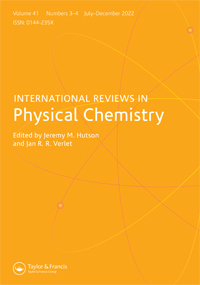Photoelectron spectroscopy of size-selected boron clusters: from planar structures to borophenes and borospherenes
IF 2.5
2区 化学
Q3 CHEMISTRY, PHYSICAL
引用次数: 187
Abstract
Photoelectron spectroscopy (PES) in combination with computational chemistry has been used systematically over the past decade to elucidate the structures and chemical bonding of size-selected boron clusters. Small boron clusters have been found to be planar or quasi-planar, consisting of a monocyclic circumference with one or more interior atoms. The propensity for planarity has been found to be a result of both σ and π electron delocalisation over the molecular plane, giving rise to concepts of σ and π multiple aromaticity. In particular, the B36 cluster has been found to possess a highly stable planar structure with a central hexagonal vacancy. This finding provides the first indirect experimental evidence that single-atom layer boron-sheets with hexagonal vacancies, dubbed ‘borophene’, are potentially viable. Another exciting discovery has been the observation and characterisation of the first all-boron fullerenes. PES revealed that the cluster consisted of two isomers with very different electron binding energies. Global minimum searches led to two nearly degenerate isomers competing for the global minimum: a quasi-planar isomer with a double hexagonal vacancy and an unprecedented cage isomer. In the neutral, the B40 cage is overwhelmingly the global minimum, which is the first all-boron fullerene to be observed and is named ‘borospherene’. Rapid progresses in our understanding of the structures and bonding of size-selected boron clusters have been made during the past decade, which will be the focus of this review. The recent findings about borophenes and borospherenes have stimulated growing interests in boron clusters and will accelerate the pace of discovery in boron chemistry and nanostructures.尺寸选择硼团簇的光电子能谱:从平面结构到硼罗芬和硼罗芬
在过去的十年中,光电子能谱(PES)与计算化学相结合,被系统地用于阐明尺寸选择硼簇的结构和化学键。小的硼团簇被发现是平面或准平面的,由一个或多个内部原子组成的单环圆周。平面化倾向是由分子平面上的σ和π电子离域引起的,由此产生了σ和π多重芳构性的概念。特别是,B36星团被发现具有高度稳定的平面结构,中心有一个六边形的空位。这一发现提供了第一个间接的实验证据,证明具有六边形空位的单原子层硼片,被称为“硼苯”,是潜在可行的。另一个令人兴奋的发现是对第一个全硼富勒烯的观察和表征。PES表明,该簇由两个电子结合能差异很大的异构体组成。全局最小值搜索导致两个几乎简并的异构体竞争全局最小值:具有双六边形空位的准平面异构体和前所未有的笼形异构体。在中性中,B40笼是全球最小的,这是第一个被观察到的全硼富勒烯,并被命名为“硼球烯”。在过去的十年中,我们对尺寸选择硼团簇的结构和键合的理解取得了快速的进展,这将是本文的重点。最近关于硼烯和硼球烯的发现激发了人们对硼团簇的兴趣,并将加速硼化学和纳米结构的发现步伐。
本文章由计算机程序翻译,如有差异,请以英文原文为准。
求助全文
约1分钟内获得全文
求助全文
来源期刊
CiteScore
14.20
自引率
1.60%
发文量
5
审稿时长
1 months
期刊介绍:
International Reviews in Physical Chemistry publishes review articles describing frontier research areas in physical chemistry. Internationally renowned scientists describe their own research in the wider context of the field. The articles are of interest not only to specialists but also to those wishing to read general and authoritative accounts of recent developments in physical chemistry, chemical physics and theoretical chemistry. The journal appeals to research workers, lecturers and research students alike.

 求助内容:
求助内容: 应助结果提醒方式:
应助结果提醒方式:


